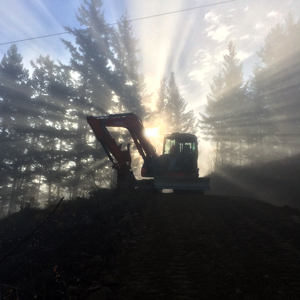Whiteline uses excavator mulching attachments to remove dry wood debris in the areas where private land meets forest. These areas are close to residential homes, also known as urban interface ares, and require care and a proper management plan to be effective at reducing the risk of wildfire. Our mulching approach is a preferred urban interface fuel reduction management plan technique for municipalities and home owners alike.
Use of prescribed fire to reduce fuel buildup can be problematic; there can be air quality concerns, problems with weed invasions after fire, and fire induced loss of ecosystem carbon and soil nutrients. The wood chips from mulching are capable of retaining moisture on the forest floor, and are able to break down into soil quickly.
The fire risk is greatest at the forest-urban interface where structures are interspersed with dense thickets of underbrush with high fuel loading. Allowing dry brush material to accumulate in close proximity to dense populations with high property values is a costly risk. Today’s changing climate conditions such as drought and wind are resulting in highly flammable fuels. Not conducting urban interface fuel reduction can mean an unacceptable risk of catastrophic wildfire and loss.
Whiteline Contracting takes urban interface fuel reduction management very seriously. Overgrowth can be a major fire hazard during the heat of summer. Forest fire season can be devastating to communities if they are not properly prepared. Fuel thinning involves removing ground brush and debris, pruning branches, and removing specific trees to reduce the risk of wildfire.
We specialize in fire mitigation services to keep your property safe, and have the experience and the right equipment to help protect your property against bush, forest, and wildfire.




